Anterior cruciate ligament rupture, ACL injury
Table of contents
How does an ACL injury occur?
The cruciate ligaments are among the most important stabilisers of the knee joint. There is an anterior and a posterior cruciate ligament. They got their name because they cross in the centre of the knee joint. The cruciate ligaments prevent the lower leg from sliding forward or backward and guide the joint during movement.
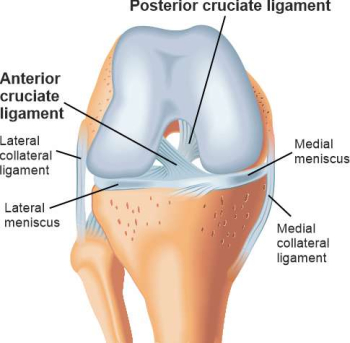
A cruciate ligament rupture is a very common injury and usually affects the anterior cruciate ligament (ACL). It is caused by excessive forces acting on the knee joint, such as those resulting from a sports or traffic accident. In the case of ACL rupture, a sudden change of direction or twisting movement with simultaneous bending or overextension often leads to the injury. [ACL injuries occur particularly frequently in contact sports (football, handball, volleyball, basketball), stop-and-go sports (tennis, squash, badminton) and skiing.
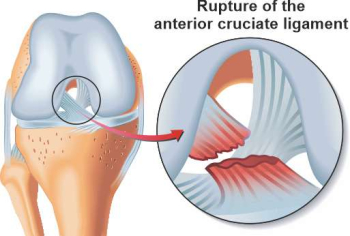
Symptoms of an ACL injury
If a cruciate ligament tears, there is usually sudden severe pain in the knee. An ACL injury is often accompanied by a tearing sound that is perceived as a crack or pop. Over the next few hours, the knee joint swells. This often leads to a restriction of movement. After the acute symptoms have subsided in the first week, a feeling of instability usually remains. Quite characteristic of this is a feeling that the knee joint gives way when walking or running (giving-way attack). The extent of the insatability depends on the other knee stabilisers, which can partly take over the function of the anterior cruciate ligament, and the training condition of the affected person.
Sometimes an ACL injury can also be accompanied by minor symptoms and therefore remains unnoticed by the affected person until a feeling of instability and insecurity sets in when walking or doing sports.
Diagnosis for an ACL injury
Based on a precise description of the cause of the injury, the typical symptoms and a thorough clinical examination to check the stability of the knee joint, the doctor can usually diagnose an ACL injury.
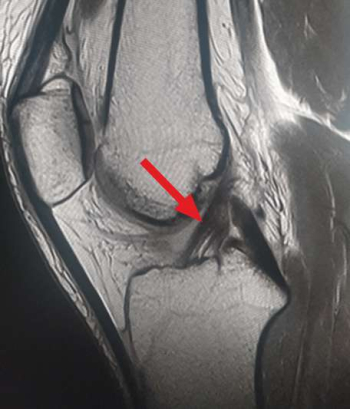
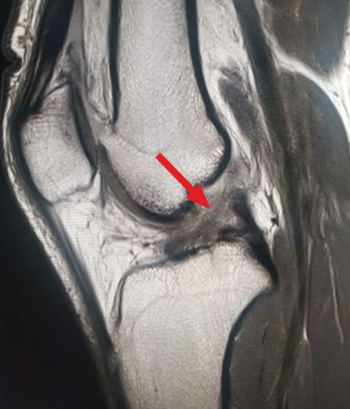
In addition, an imaging procedure such as an X-ray and magnetic resonance imaging (MRI) should be performed to confirm the diagnosis and clarify any concomitant injuries. The presence of concomitant injuries, along with other factors, influences the further choice of therapy.
Treatment for ACL injuries
In principle, an ACL injury can be treated both conservatively, i.e. without surgery with physiotherapy and medicinal pain therapy, and surgically with an arthroscopic cruciate ligament reconstruction. Whether an surgery is necessary depends on the extent of the instability, the sporting activity, the age of the patient and existing concomitant injuries. Persistent instability after an ACL injury leads to strong shear forces, especially under load, which cause damage to the joint cartilage and meniscus. The higher the level of sporting activity, the more likely surgical reconstruction is indicated. A distinction is made between four activity levels:
| I | Activities with weight-bearing rotation, contact sports |
|---|---|
| II | Hard physical work, tennis, skiing |
| III | light physical work, jogging, jumping |
| IV | Everyday activities, sedentary work |
If a patient who is not very active in sports has a high degree of instability, surgery is also recommended.
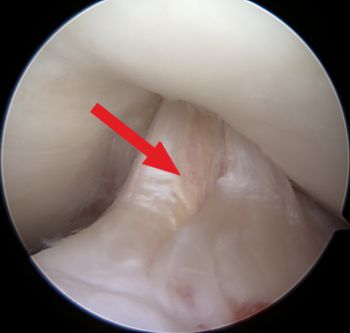
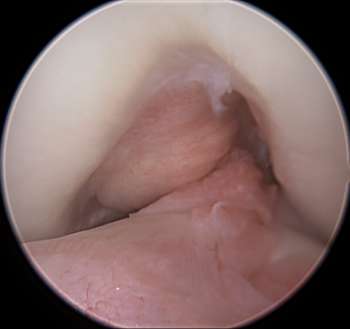
Conservative therapy for ACL injuries
In the acute phase after the ACL injury, decongestant and pain-relieving measures are in the foreground. The knee should be cooled and elevated immediately after the injury. Furthermore, the knee can be immobilised with an orthosis or bandage and relieved with forearm crutches. Pain and swelling can be treated by taking painkillers and applying them locally.
Once the acute complaints have subsided after the ACL injury, physiotherapeutic measures such as muscle building and coordination training (proprioception training) can be started. The aim of conservative therapy is to compensate for the lost ligament function in the knee after an ACL injury by improving muscular stabilisation.
Surgical therapy - ACL reconstruction
In arthroscopic ACL reconstruction, the patient's own tendons are usually used as a replacement (= graft) for the torn cruciate ligament. There are various tendons to choose from:
- Semitendinosus and gracilis tendon (STG)
- part of the patellar tendon (BTB)
- part of the quadriceps tendon.
In addition to the body's own tendons, it is also possible to use so-called allografts. These are tendons from deceased donors that can be transplanted after a complex preparation. Each technique has certain advantages and disadvantages. Therefore, the choice of graft should be made individually for the patient's needs.
The correct positioning of the graft is very important during the operation, as this is the only way to achieve good stability and function. Thanks to the latest techniques, it is now possible to achieve an anatomical and thus correctly functional positioning of the cruciate ligament replacement.
In order to fix the cruciate ligament graft, a drill channel is drilled into the femur and the tibia at the respective attachment point of the old cruciate ligament, into which the two graft ends are pulled. There are various options for fixing the graft in the drilled channels. One type of fixation is the use of a small metal leaflet (endobutton) that lies against the outside of the bone and prevents the graft from sliding back. Another option is to fix the graft with a screw in the drill channel. For this purpose, a bioresorbable interference screw (dissolves by itself over time in the body) or a metal screw is inserted next to the graft in the drill channel.
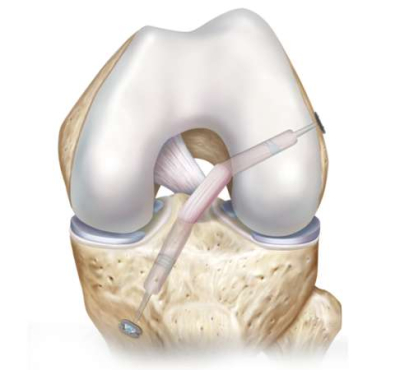
Surgical therapy - ACL refixation
If certain conditions are met, an surgery to preserve the cruciate ligament (ACL refixation) can be performed. Since the cruciate ligament has a very poor healing potential, the ACL injury for cruciate ligament refixation must be relatively fresh and the ACL must be torn as close as possible to the attachment to the femur. Various techniques are now available for refixation. For example, the ACL can be refixed to the thigh bone with dowels or fixed with a metal plate (endobutton) that lies against the outside of the bone. In addition, the ACL can be reinforced (augmented) with an artificial thread to relieve the strain on the ACL during the healing phase.
The great advantage of ACL refixation is that the body's own cruciate ligament can be preserved and no tendon has to be removed for reconstruction. Furthermore, important receptors (proprioceptors) of the cruciate ligament remain intact, which are responsible for the perception of position and movement in space. This enables faster rehabilitation after the operation.
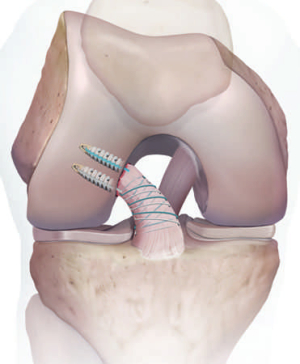
Aftercare for ACL surgery
Since the new surgical techniques have a very stable fixation of the graft, forearm crutches are only necessary for about 2-4 weeks to relieve the strain. A splint is usually not necessary. Ergometer training can be started 2 weeks after the operation, running is possible after 6-8 weeks, sport-specific training after 6 months. Sports such as football, handball, squash, badminton and skiing should only be practised after 9-12 months.
Frequently asked questions about ACL injuries
How long do I have to stay in hospital ACL surgery?
Usually you can go home the next day after ACL surgery. The exact duration of the hospital stay depends, of course, on the individual pain situation and the mobilisation of the patient.
Does an ACL injury always require surgery?
No, whether you should have an ACL injury operated on or treated conservatively (with physiotherapy and medicinal pain therapy) depends on various factors. Basically, the higher the instability and the higher the sporting activity (demands on the knee joint), the sooner an operation is necessary. Furthermore, the age of the patient and existing concomitant injuries (e.g. meniscus tear, cartilage defects) also influence the therapy decision. If there is persistent instability after an ACL injury, strong shear forces occur in the joint that can damage the joint cartilage and the meniscus. For this reason, the ACL injury should be treated surgically if instability persists.
How long will I need crutches after ACL surgery?
The new techniques for fixing the ACL graft are very stable, but forearm crutches should still be used for about 2-4 weeks to avoid putting full weight on the joint and to allow the graft to heal.
What is the best surgical technique for ACL injuries?
This cannot be answered in general terms and should be decided individually for each patient. Each surgical technique has certain advantages and disadvantages. The correct anatomical placement of the graft at the attachment points of the original ACL is crucial. Various tendon grafts and fixation options are available for ACL reconstruction. Which one is most suitable for the patient depends on possible concomitant injuries, previous operations and demands on the knee joint (e.g. kneeling activities) and should be discussed with the treating knee specialist.